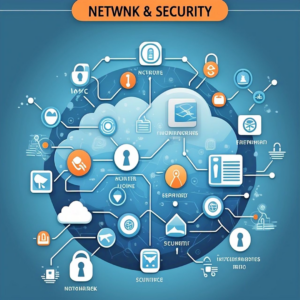Network and security in Azure
Introduction
In the realm of cloud computing, Microsoft Azure stands out as a premier platform offering a comprehensive suite of services designed to enhance cloud infrastructure security. As organizations in the UAE increasingly migrate to the cloud, understanding the complexities of network architecture and security protocols within Azure is critical to safeguarding applications and data. One essential component of Azure’s security framework is Azure Firewall, a cloud-native network security service that provides threat protection, traffic filtering, and deep visibility into network activity. This blog explores key components of network security in cloud computing, best practices, architectural patterns, and the tools available for effective management.
1. Understanding Azure Security
Azure provides a robust security framework that allows organizations to build secure and scalable network architectures while prioritizing cloud infrastructure security. The key components that contribute to Azure security include:
Virtual Networks (VNet)
A VNet represents your own network in the cloud, enabling resource segmentation and controlled communication. VNets can be connected to on-premises networks using VPN gateways or Azure ExpressRoute, with Azure Firewall providing enhanced security by enforcing network traffic filtering and threat protection.
Subnets
By partitioning your VNet into subnets, you can manage resources effectively. Each subnet can host various resources, including virtual machines (VMs), Azure App Services, and Azure SQL Databases.
Network Security Groups (NSGs)
NSGs regulate inbound and outbound traffic to Azure resources through rules based on source and destination IP addresses, ports, and protocols.
Azure Firewall
This managed, cloud-based network security service safeguards Azure Virtual Network resources with high availability and scalability, allowing for the creation and enforcement of security policies.
Azure DDoS Protection
This service is paramount for protecting applications from Distributed Denial of Service (DDoS) attacks, ensuring continued application availability even under threat.
2. Network Security in Cloud Computing
Implementing Azure Firewall as a central security component helps enforce traffic control and threat protection. Efficiently designed architectures contribute to both security and operational efficiency. When designing a secure network architecture in Azure, it’s essential to consider various network topologies tailored to organizational needs:
Hub-and-Spoke Model
This topology uses a central hub VNet to connect multiple spoke VNets, simplifying management and enabling centralized security and monitoring.
Mesh Network
In a mesh configuration, every VNet can communicate directly with each other, ideal for applications requiring high interconnectivity.
Hybrid Network
A hybrid network framework seamlessly integrates on-premises infrastructure with Azure, facilitating the migration to cloud solutions while retaining existing resources.
3. DevSecOps Practices in Azure
Incorporating DevSecOps practices into Azure’s continuous integration and deployment (CI/CD) pipelines ensures security is integrated at every stage of development. Azure supports various security measures:
Identity and Access Management (IAM)
Azure Active Directory (Azure AD) serves as the backbone of identity management, managing user identities and controlling resource access through role-based access control (RBAC). When combined with Azure Firewall, organizations can enforce network security policies, ensuring that only authorized users and services can access protected resources.
Authentication and Authorization
Azure offers diverse authentication methods, including multi-factor authentication (MFA), OAuth, and OpenID Connect, with authorization managed by Azure AD.
Data Protection
Azure’s array of data protection mechanisms includes encryption both at rest and in transit. Azure Key Vault secures cryptographic keys and secrets.
Compliance and Governance
Azure’s governance tools, such as Azure Policy, facilitate compliance with organizational standards, ensuring that regulatory requirements are met.
4. Best Practices for Network Security
To bolster network security in Azure, organizations should adopt several best practices:
Implement Network Segmentation
Utilize VNets and subnets to effectively segment resources based on their security needs, thereby reducing the attack surface. Implement Azure Firewall to enforce network security policies and control traffic flow between subnets.
Utilize NSGs Efficiently
Define and manage NSGs to control traffic flow to and from resources adaptively, reviewing them regularly to align with evolving security requirements.
Activate DDoS Protection
Ensure that Azure DDoS Protection is enabled to defend applications from potential threats, providing real-time monitoring and mitigation capabilities.
Monitor Network Traffic
Use Azure Monitor and Network Watcher to gain insights into traffic patterns, enabling the detection of anomalies and potential security risks.
Conduct Regular Access Reviews
Carry out periodic assessments of user access and permissions to ensure only authorized personnel have access to sensitive resources.
5. Automation and Management Tools
Azure boasts various tools designed to automate and manage network and security configurations:
Azure Resource Manager (ARM) Templates
These templates allow for consistent definition and deployment of Azure resources, facilitating the automation of VNets, subnets, NSGs, Azure Firewall, and other networking elements.
Azure DevOps
Providing a suite of CI/CD tools, Azure DevOps automates the deployment of network resources and security configurations efficiently.
Azure Policy
Deploying organizational standards at scale, Azure Policy assesses compliance and can automatically apply to newly created resources.
Azure Security Center
A unified infrastructure security management service, Azure Security Center provides advanced threat protection across hybrid workloads, delivering security recommendations and identifying vulnerabilities.
6. Conclusion
As organizations in the UAE increasingly embrace cloud computing, grasping the nuances of network security in cloud computing and Azure security is vital for protecting resources and ensuring compliance. By leveraging Azure cloud services and its robust networking capabilities, including Azure Firewall, organizations can establish secure, scalable, and efficient cloud environments. Adhering to best practices and integrating DevSecOps practices, advanced security features, and automation tools positions Azure as a leader in cloud infrastructure security—empowering organizations to innovate confidently while maintaining a strong security posture.
Do you like to read more educational content? Read our blogs at Cloudastra Technologies or contact us for business enquiry at Cloudastra Contact Us.
